#anatolian deities
Text
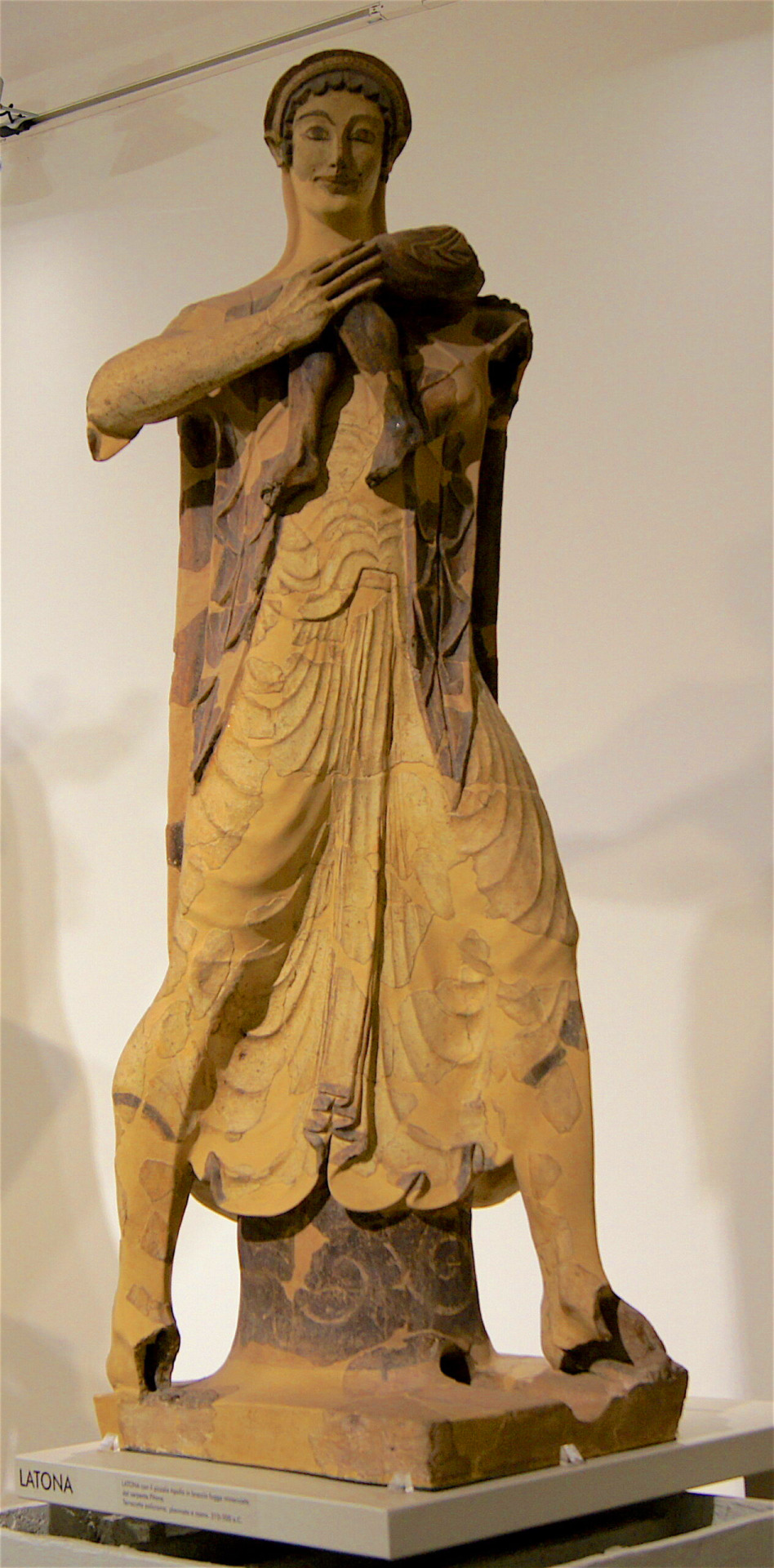
Latona di Veio
This massive statue of the Mediterranean Goddess Latona, holding Apollo in Her hands, was found in the Etruscan city of Veio. In 2022, the statue was set up to restoration - a "much needed" one. The sculpture was found alongside statues of Apollo, Hercules, and Hermes - perhaps all parts of a singular compound scene at an ancient temple.
A legal company Carbonetti e Associati funded the project.
Source, further reading, and restoration process: 🏺 🏺 🏺
#LATONA 🌻#ANTIGÜEDADES 💎#Fun fact: did you know that Apollo was born before Artemis and their birth wasn't always twin birth?#ancient art#art#mediterranean#etruscan#etruscan art#leto#latona#greek mythology#greek gods#anatolian gods#leto deity
98 notes
·
View notes
Text
[...P]rior to 4500 B.C. (the onset of the Bronze Age), widespread cultural uniformity throughout Europe and Western Asia centered on the worship of a great-goddess figure, first in the form of a Mistress of Wild Animals (often depicted as androgynous or hermaphroditic) and later, after the invention of agriculture, in the form of a Grain Goddess. Commonly associated with this Great Goddess, especially after 7000 B.C., was a subordinate male deity, often depicted in the form of a bull or a horned figure.
Arthur Evans, “The God of Ecstasy: Sex Roles and the Madness of Dionysos,” 1988
#arthur evans#books#minoan#phrygian#anatolian#deities#horned#mother#androgyny#trans#this maps so fascinatingly onto the stuff we're doing with the agdistine order#like... so directly#we thought it was greek shit we were into and turns out it's minoan#colonizers! oy!
17 notes
·
View notes
Text
I want to spend the next couple of posts looking at Cybele, an Anatolian mother goddess who ended up being adopted by the Greeks and Romans.
Cybele may have been one of the most ancient goddesses in the world. In Çatalhöyük, an Anatolian site that ranks as one of the oldest settlements in the world, archaeologists found figurines of a mother goddess, flanked by lions (a signature of Cybele), that date to 8,000 years ago.

Here’s Cybele depicted over 5,000 years later (around 500 BCE), in a figurine discovered in northwestern Turkey, accompanied by musical-instrument-playing children rather than lions.

Cybele was a very important goddess in her home region of Anatolia, which came to be known as Phrygia — the “Mountain Mother,” associated with certain rocky landscapes. But she eventually became one of the most important deities in the ancient Mediterranean world.
{WHF} {Ko-Fi} {Medium}
568 notes
·
View notes
Text
But anyway, before I got distracted by my last post.
Hekate.
I wanted to share some things I've learned about Her.
1) She is The Unseen Witness. This is an epithet I personally have given Her, but which derives from Her role as Persephone's savior and guide to and from the underworld.
2) She's pre-Greek. Anatolian, actually. That's how I personally like my deities—from a localized cult but so powerful they got picked up by a nearby pantheon (Diana is another example of this).
3) She's a goddess that was traditionally worshiped not in temples, but at homes. In my personal experience, She has a LOT of presence in apartments and shelters (especially shelters), as they are inherently liminal living situations.
4) She presides over Dogs and Polecats (like a weasel or ferret) and Horses, so I view Her as a goddess with dominion over all domesticated pets.
5) Hekate faces the three directions the roads lead at a Y- or T-junction, so in my personal practice I understand The Horned God to stand at Hekate's back and watch The Wild Way for Her. On my altar I have my representation of The Horned God facing away from me. Hekate did call me a sneak for that one, though, so YMMV.
6) I get the vibe she doesn't like to share altar space so she'll be getting a bookshelf of her own soon. You can use keys, the triple moon, and various momento mori (like bones, or the charm I made with a sprig of dead rosemary and a beetle carcass) to represent her in an altar space.
7) Herbs and Plants: Garlic, Yew, Mandrake, Dandelion, Belladonna, Cyclamen, Hemlock, Mint, Oak, Date Palms, Willow, Wolf's Bane. You'll notice many plants in her domain are poisonous or otherwise baneful. To this extent, she presides over all baneful plants.
8) She basically requires you to prioritize self-improvement and learning. Therapy and working out and reading and journaling can all be devoted to Her.
9) UPG but I also associate Her with mushrooms, moths, foxes, and rose thorns. She is carrion birds and the rust that eats at iron. She is the dark side of the moon and She likes it that way.
#hekate#hecate#diety work#witchblr#witchcraft#witch#paganism#diety#shadow work#baneful herbs#baneful magic#roaenpost#hidden upg in the tags but she also likes it when you question her rules as long as you do so respectfully
80 notes
·
View notes
Text
💫Mythical Astrology💫
A collection of gods and goddesses associated with each sign~ Before you say something, yes! I AM aware that some of these deities are the same entity with different names. I wanted to include all names so readers could recognize the ones they knew :) Talk to me niiiiiiiiiiiiiiiice
Aries
Amun (Egyptian), Anat (Mesopotamian/Ugaritic/Egyptian), Ares (Greek), Badb (Irish), Belenus (Celtic), Cybele (Anatolian), Durga (Hindu), Hecate (Greek), Hestia (Greek), Indra (Hindu), Ishtar (Mesopotamian), Khnum (Egyptian), Macha (Irish), Marduk (Babylonian), Mars (Roman), Minerva (Roman), The Morrigan (Irish Celtic), Nergal (Mesopotamian), Ra (Egyptian), Sekhmet (Egyptian), Tiamat (Babylonian)
Taurus
Aphrodite (Greek), Asherah (Semitic), Astarte (Middle Eastern), Ba'al (Canaanite), Bacchus (Greco-Roman), Bast (Egyptian), Cernunnos (Celtic), Dionysus (Greek), Flora (Roman), Frigg (Norse), Gaia (Greek), Hathor (Egyptian), Horus (Egyptian), Indra (Hindu), Ishtar (Mesopotamian), Isis (Egyptian), Jupiter (Roman), Krishna (Hindu), Lakshmi (Hindu), Maia (Greek), Marduk (Babylonian), Mithra (Iranian), Osiris (Egyptian), Poseidon (Greek), Ptah (Egyptian), Venus (Roman), Zeus (Greek)
Gemini
Apollo (Greek), Artemis (Greek), Dumuzid (Sumerian), Enki (Sumerian), Hermes (Greek), Inanna (Mesopotamian), Janus (Roman), Krishna (Hindu), Mercury (Roman), Odin (Norse), Seshat (Egyptian), Thoth (Egyptian)
Cancer
Artemis (Greek), Ceres (Roman), Demeter (Greek), Diana (Roman), Isis (Egyptian), Juno (Roman), Kuan Yin (Chinese/Buddhist), Luna (Roman), Mercury (Roman)
Leo
Amun (Egyptian), Anat (Mesopotamian/Ugaritic/Egyptian), Bast (Egyptian), Cybele (Anatolian), Devi (Hindu), Diana (Roman), Durga (Hindu), Freyja (Norse), Hathor (Egyptian), Helios (Greek), Hera (Greek), Inanna (Mesopotamian), Ishtar (Mesopotamian), Juno (Roman), Mithra (Iranian), Nanna (Mesopotamian), Nergal (Mesopotamian), Ra (Egyptian), Sekhmet (Egyptian), Vishnu (Hindu)
Virgo
Anat (Mesopotamian/Ugaritic/Egyptian), Artemis (Greek), Demeter (Greek), Diana (Roman), Hestia (Greek), Inanna (Mesopotamian), Iris (Greek), Ishtar (Mesopotamian), Isis (Egyptian), Kore (Greek), Nanna (Mesopotamian), Odin (Norse), Persephone (Greek), Vesta (Roman)
Libra
Aphrodite (Greek), Athena (Greek), Cernunnos (Celtic), Frigg (Norse), Hephaestus (Greek), Isis (Egyptian), Justitia (Roman), Ma'at (Egyptian), Minerva (Roman), Mithra (Iranian), Nemesis (Greek), Njord (Norse), Shiva (Hindu), Thoth (Egyptian), Venus (Roman), Vishnu (Hindu)
Scorpio
Anubis (Egyptian), Ereshkigal (Mesopotamian), Hecate (Greek), Hel (Norse), Isis (Egyptian), Mars (Roman), Njord (Norse), Osiris (Egyptian), Persephone (Greek), Pluto (Roman), Set (Egyptian)
Sagittarius
Anat (Mesopotamian/Ugaritic/Egyptian), Artemis (Greek), Athena (Greek), Diana (Roman), Epona (Gallo-Roman), Hades (Greek), Isis (Egyptian), Jupiter (Roman), Mars (Roman), Nergal (Mesopotamian), Rhiannon (Welsh), Thor (Norse)
Capricorn
Agni (Hindu), Aphrodite (Greek), Ba'al (Canaanite), Dionysus (Greek), Ea (Babylonian), Enki (Sumerian), Faunus (Roman), Freyja (Norse), Freyr (Norse), Gaia (Greek), Hecate (Greek), Juno (Roman), Loki (Norse), Pan (Greek), Perun (Slavic), Saturn (Roman), Thor (Norse)
Aquarius
Astarte (Middle Eastern), Ea (Babylonian), Ishtar (Mesopotamian), Isis (Egyptian), Juno (Roman), Nut (Egyptian)
Pisces
Aegir (Norse), Aphrodite (Greek), Cupid (Roman), Diana (Roman), Ea (Babylonian), Enki (Sumerian), Eros (Greek), Neptune (Roman), Poseidon (Greek), Sedna (Inuit), Venus (Roman), Vishnu (Hindu)
#mythology#astrology#deities#gods#goddesses#associations#correspondences#egyptian#mesopotamian#greek#roman#celtic#norse#hindu
98 notes
·
View notes
Note
Hi, sorry if this has been asked before, but do you have any reliable sources that talk about Ashtar? I'm also looking for articles that talk about El/Ilu; and Shalim and Shahar as well. I appreciate any form of help.
I've answered a similar Ashtar question a few months ago, refer to the bibliography here.
I do not have much to offer when it comes to Shahar and Shalim because as far as I can tell most scholarship focuses on exegesis of the Bible, which is something I have next to no interest in. I've answered a question about them here; the main source to depend on is Pardee's Ritual and Cult in Ugarit.
When it comes to El, the basic selection of sources dealing with Ugaritic religion should obviously be the start: Smith's Baal Cycle commentaries, Pardee's aforementioned book, Rahmouni's Divine Epithets in the Ugaritic Alphabetic Texts, Handbook of Ugaritic Studies, etc. For more specialized information I recommend:
a) Il in Personal Names by Alfonso Archi (early history, and why names with the element il and its cognates do not necessarily refer to a specific deity in pre-Ugaritic sources)
b) West Semitic god El in Anatolian Hieroglyphic Transmission by Ilya Yakubovich for the first millennium BCE
c) The God Eltara and the Theogony by Anna Maria Polvani for El's Hurro-Hittite career (there's also the Elkunirsa myth but I do not think there's any recent treatment of it, so your best bet is to just read the translation in Hoffner's Hittite Myths from the 1990s)
d) The Dwelling of ˀIlu in Baˁlu and ˀAqhatu by Madadh Richey for some lexical considerations regarding El's residence
e) God (Ilu) and King in KTU 1.23 by Theodore J. Lewis for El's role as the king of the gods
Also, it's worth checking out Wiggins' monograph A reassessment of Asherah: with further considerations of the goddess since while hardly focused on El, it does discuss Athirat's relationship with him in the Ugarit section. Similarly, might be worth looking into this author's Shapash article.
37 notes
·
View notes
Photo

Rhea
Rhea (also spelt Rheia) is a Titan and a mother goddess in Greek mythology. She is the daughter of Gaia (Earth) and Uranus (Heaven) and the mother of the great deities of Mount Olympus. Rhea was closely associated with the Phrygian (Anatolian) mother goddess, Cybele. Her Roman counterpart was Ops, a fertility deity and the goddess of the harvest.
Rhea is most well-known as the mother of the Olympian deities, especially Zeus, who she saved from being swallowed by his father, Cronus. As an earth and fertility goddess, she was worshipped widely throughout the ancient Greek world.
Continue reading...
67 notes
·
View notes
Text
“In questioning the nature and purpose of the oracular shrines and the priestesses who gave advice, historical records, especially in Babylon and Greece, explain that they were primarily utilized for vital political, governmental and military matters. It was not only the belief that the priestesses could see into the future that made oracular divination so popular but the idea that these women were understood to be in direct communication with the deity who possessed the wisdom of the universe. It is evident from the accounts of the people who believed in prophetic revelation that they did not view the future as totally predestined and determined by uncontrollable fates but rather as something that could be acted upon, as long as one knew the most advantageous action to take. The oracular priestesses were not consulted for a firm prediction of the future but for counsel as to the best strategy, considering the situation. This advice was available at shrines all the way from Greece to Mesopotamia.
Evidence of the Goddess in Sumer, under the names such as Nina, Ininni or Inanna, suggests that divine revelation was an aspect of the religion from the most ancient times. In later Babylon, records of Queens Sibtu and Nakia revealed the importance and influence of the oracular priestesses in the political affairs of Babylon and the city of Mari. Babylonian prophetesses were known as appiltu or muhhtu. It is rather interesting that the Hebrew word zonah is at times defined as "prostitute" and at times as "prophetess."
J. Hastings wrote that in Egypt, "In the Old and Middle Kingdoms, women of important families often bear the title 'prophetess.' It was nearly always the goddesses Hathor and Neith that they served in this capacity."
D. S. Russell wrote of the prophetesses who came to be known as the Sibyls. The Sibyls were often identified with a prophetess of Anatolia, named as Sybella, whom we may suspect has some connection with the Goddess known there as Cybele. It was, in fact, the Sibyls of Rome who were responsible for having the worship of the Anatolian Cybele brought into Rome. According to Russell,
These Sibylline oracles were written during the latter half of the second century BC in Alexandria. They are imitative of the Greek Sibyls who exercised a considerable influence upon pagan thought both before and after this time. The pagan Sibyl was a prophetess who, under the inspiration of the god, was able to impart wisdom to men and to reveal to them the divine will. There were many varieties of such oracles in different countries and in Egypt in particular they came to have an increasing interest and significance.
At the temple in Jerusalem in about 620 BC, Ezekiel spoke of the women who dared to prophesy "out of their own heads." Even the much later canons of St. Patrick, who is said to have brought Christianity to "pagan" Ireland, warned against "pythonesses." Pythoness is still defined in most contemporary English dictionaries as a prophetess or witch.”
-Merlin Stone, When God Was a Woman
32 notes
·
View notes
Text


Atarata (Atargatis/Astarte) & (Baal) Hadad

Shamash (Sun God) & Syn (Moon God)

Unknown Deities. Goddess Second-from-left may be Kubaba?
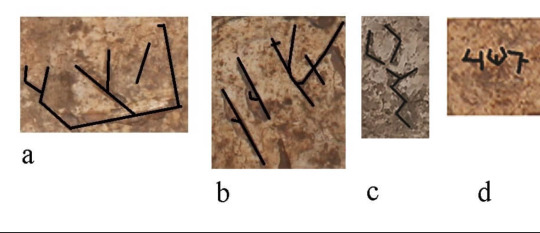
Aramaic names of deities:
a) HDD “Hadad”
b) ’TRT “’Attar‘ata”
c) Ṣ(YN)? “Sîn”
d) MK[N]-’BW[’] R[’]Š TŠḤ[N] “Mukīn-abūa the head (re’š) of Tušhan”
The Başbük Rock Wall Panel
Başbük, Türkiye
c. 750 BCE?
Wall picture of several Syro-Anatolian deities.
Drawings by Selim Ferruh Adalı
Source:
ANE Today (News Article)
Cambridge Core (Original Article from Cambridge University Press)
#shamash#sin#yarach#yarich#baal#hadad#adad#baal hadad#astarte#ashtart#atargatis#atarata#syn#kubaba#canaan#canaanite gods#phoenicia#phoenician gods#aram#aramean gods#syria#syrian gods#levantine gods#mesopotamia#mesopotamian gods#pagan gods#polytheism#archeology#magic#witchcraft
14 notes
·
View notes
Photo
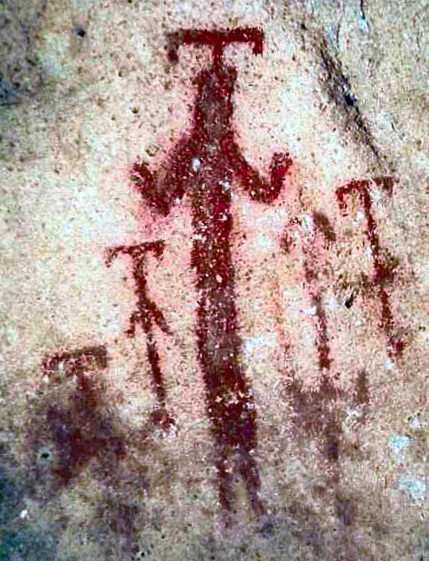


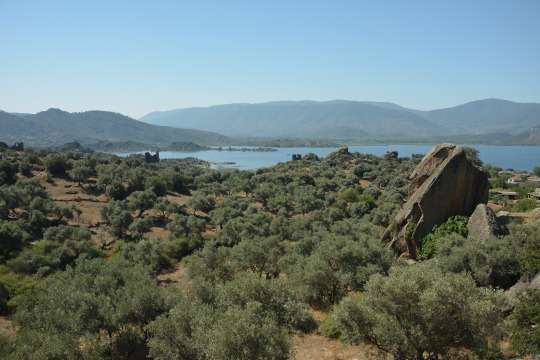


Cave painting with representation of the Weather Gods. Dated to c.6000 BC. Mount Latmos, modern-day Turkey.
Since prehistoric times the Latmos was one of the sacred mountains in Anatolia. Upon its peak the old Anatolian rain-and weather-god together with a local mountain deity were worshipped. The prehistoric weather god was later replaced by the Hittite deity Tarhunt and then by the god Zeus of Classical Greece. The local mountain deity lived on in Greek mythology as Endymion, the young shepherd and hunter, and lover of the lunar goddess Selene. The Latmos remained a sacred mountain until the end of Medieval times. At that time it was called “Latros”. Monks driven out of the Sinai and the Arabic peninsula (today Yemen) sought refuge here in the 7th century AD.
The fascinating rock landscape of the Latmos mountains as well as the archaeological monuments of this region are threatened with destruction by the constant expansion of stone quarries in this area.
Our new design: Weather Gods of Latmos. Available on Amazon and Redbubble (onelink): https://geni.us/latmos
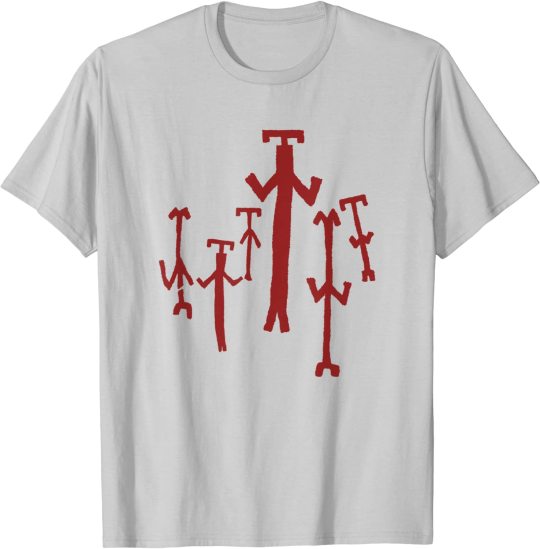
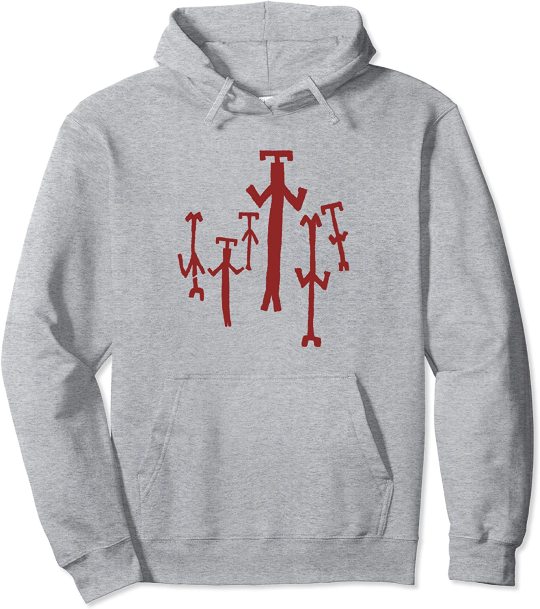
70 notes
·
View notes
Text
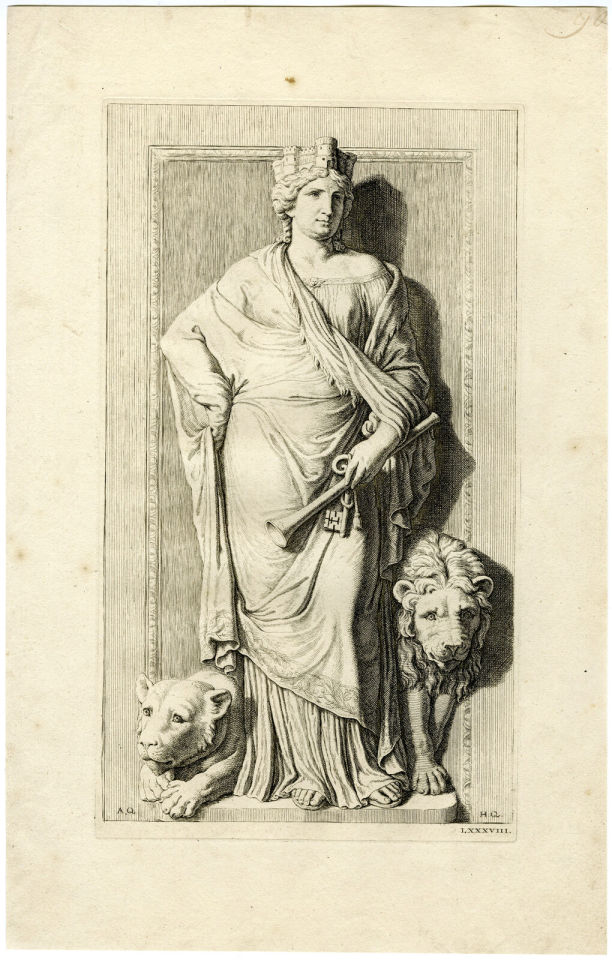
Cybele with two lions at her feet
"This scarce original antique print shows a statue of Cybele, the Roman/Anatolian mother Goddess, two lions at her feet. After Artus Quellinus' reliefs and statues in the Amsterdam City Hall. Engraving/etching on verge (hand laid) paper. From: 'Architecture, peinture et sculpture de la Maison de Ville d'Amsterdam, representee en CIX figures en taille-douce (…),' published in Amsterdam by Gerard valk, 1719.
"Made by Hubertus Quellinus after Artus Quellinus. Hubertus Quellinus or Hubert Quellinus (August 15, 1619, Antwerp – 1687) was a Flemish printmaker, draughtsman and painter and a member of the prominent Quellinus family of artists. His engravings after the work of his brother, the Baroque sculptor Artus Quellinus the Elder, were instrumental in the spread of the Flemish Baroque idiom in Europe in the second half of the 17th century. Artus Quellinus also known as Artus (Arnoldus) Quellijn, Artus Quellinus I or Artus Quellinus the Elder (30 August 1609, Antwerp – 23 August 1668, Antwerp) was a Flemish sculptor. He is regarded as the most important representative of the Baroque in sculpture in the Southern Netherlands. His work had a major influence on the development of sculpture in Northern Europe."
[x]
52 notes
·
View notes
Text
The light of the hidden sun
An idea I fixate on sometimes is the esoteric mythological idea of the chthonic sun - that is, the sun in the underworld, most particularly in the sense of a dark double of the sun in the sky. In a Satanic context, that's reflected in the idea of Satan as the Sun, in the work of Aleister Crowley's presentation of Satan as the "spiritual sun". Here, though, I'll focus on a more Pagan meaning that ultimately connects to and undergirds the broader polycentric philosophy of Satanism and Paganism that I have. This is basically a long-winded expansion of my previous exploration of this idea via a Twitter thread yesterday.
It all starts out from an exploration of the seemingly rather paradoxical idea of Hades, the Greek god of the underworld par excellence, was also, in his own way, the sun. I remember stumbling on a Wordpress article about the idea, found it fascinating, but struggled to find support for it. Yet, more recently, I have come across something that perhaps lends support to the idea of the "solar Hades" being present within an actual Hellenic cultus, and with an attached theological context even.
In Leonard Thompson's "ISmyrna 753: Gods And The One God" (which you may find as part of a collection of essays titled Reading Religions in the Ancient World), we find a study of a particular funerary inscription that was discovered in 1875 at the Pagos Hill in Smyrna, an ancient Greek city located in what is now the Izmir Province in Turkiye. This inscription describes a sanctuary that was dedicated to numerous deities: Artemis, Helios Apollo, Zeus, Plouton Helios, Koure Selene, Men (an Anatolian god of the moon), and a divinity who seems to have been referred to as "God Himself". This is an interesting element, as it invites questions as to the identity of "God Himself", and the extent of its relationship to the broader "Western" monotheistic conception of God. The inscription is dated between the 1st and 2nd century, which may allow us to speculate about the possible influence of early Christianity or possibly some developments of Hellenistic Judaism that emerged at that time. However, the focus for me is the figure of Plouton Helios, who seems to be none other than Hades in solar form.
Plouton, you may remember, was one of the more polite names given to the god otherwise known as Hades. Hades may have occupied an incredibly important position as the lord of the dead, but he was not often worshipped directly or in name by the Greeks, who feared him because of his association with death. Even the name Hades was not often uttered because the god was seen as "most hateful to mortals", and so he was more often worshipped under different names. Plouton was one of them, and as Plouton he was worshipped as the lord of the fertility and mineral wealth that dwelled beneath the earth. So, then, Plouton Helios is to be understood as a distinct form of Hades, whose epithet surely denotes him as the sun. His consort, Koure Selene, is to be understood as an appearance of the goddess Kore, or Persephone, whose epithet denotes her as the moon.
In any case, Plouton Helios is contrasted with Helios Apollo; the former is an appearance of Plouton/Hades whose epithet is Helios, the latter is an appearance of Helios whose epithet is Apollo. Helios Apollo is perhaps meant to be understood as the daylight sun; both Helios and Apollo as standalone deities each tended to represent the sun and its light to some extent. By implication, then, Plouton Helios represents the sun in a different aspect. A similar contrast is established between Koure Selene and Artemis, in that Artemis is paired with Helios Apollo and, in that setting, she is pretty explicitly associated with the moon.
Plouton Helios as an expression of Hades is probably unique to Smyrna, but what is relevant for me is the meaning of Plouton Helios. According to Thompson, one interpretation, which is attributed to Porphyry and Heraclitus, suggests that Plouton and Kore represent the cycle of vegetation. In this interpretation, Plouton is the sun going down below the earth or around the lower hemisphere, drawing down the fertility of the seeds during the winter solstice or snatching up the shoots. In such a context, Plouton Helios and Koure Selene could have represented with that cycle of vegetation that then also resonated into broader themes pertaining to the cycle of life and death at large. But there's another meaning in play as well: the philosophical theme of the two suns.
Plutarch in On the E at Delphi discusses a theology that was ostensibly imparted to him by the philosopher Ammonius of Athens. This theology centres the god Apollo as a representative of Being itself, which is in turn represented by God, or rather "The One" ("The E"). In answer to the question "What is Being?", Ammonius says that "God", who is held to be eternal, uncreated, and incorruptible, is the sole source of Being, and that for this reason "God" is called Apollo or Apollon. This is supposedly because the name Apollo meant "denying the many", signifying the rejection or negation of multiplicity on behalf of the complete and ineffable unity of Being. But while Apollon was "The One", Plouton was "the many". Plouton, per Ammonius, was obscurity, darkness, and oblivion, whereas Apollon was clarity, light, and memory. Plouton, as Hades, was the realm of the unseen into which all beings pass upon their dissolution, while Apollon, as Helios, was the visible realm of embodied life. If the name Hades was meant to mean "invisible", "unseen" or "the unseen/invisible one", then this connotation makes perfect traditional sense.
It's hard not to escape a sense of the dualism that would later develop into Christian dualism. God, as "The One" and as Apollon, is unambiguously tied to Being, and simultaneously to light, memory, and the visible world, while Plouton/Hades, while not necessarily regarded as "evil", is presented as an antithesis to all of the traits that Ammonius affixes to his "God". Perhaps it is not entirely coincidental that Helios, as the sun god par excellence, would come to be syncretised with Jesus Christ as Christianity began to emerge in Rome, while Satan, in the medieval context, would increasingly take on a role contexutally and aesthetically similar to Hades.
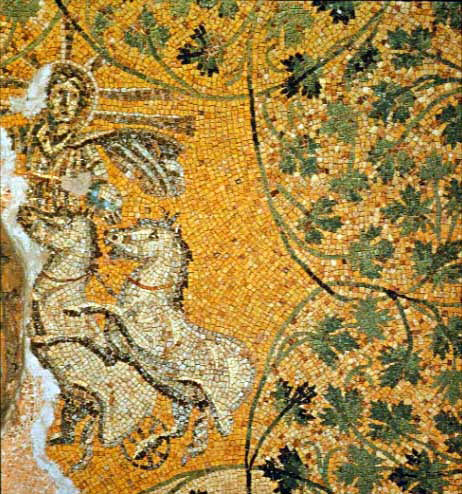
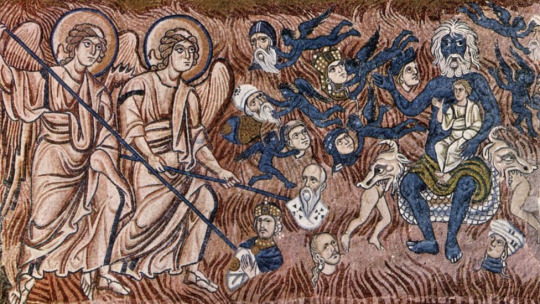
But of course, there are ways to play with the theme presented by Plutarch via Ammonius. In Plutarch's context, Helios Apollo and Plouton Helios emerge as two suns: one sun is the visible sun, the celestial or diurnal sun, in this case representing the unity of Being, and the other sun is the invisible sun, the chthonic or nocturnal sun, in this case representing the unseen realm and the division and dissolution of Being. There are certain approaches to that idea that can be explored. For one thing, my mind found itself drawn to an ostensibly similar split in Kabbalah between Kether, the sefirot representing the primordial unity of God, and Thaumiel, its qliphothic counterpart representing the denial of this unity and, in its place, the counterveiling primordial division of will. Of course, for our purposes, that's where the similarity ends. Still another consideration is the broader pre-Christian landscape of underworld traditions, in which the underworld was not uncommonly imagined as a sort of surreal double of the living world rather than simply a bleak chamber of eternal punishment. However, the theme of the visible and invisible sun also has references with certain later ideas found within Neoplatonism.
In Against The Gallileans, the Roman emperor Flavius Claudius Julianus established that, per Neoplatonist parlance, there was both a visible sun and an invisible sun:
Plato gives the name gods to those that are visible, the sun and moon, the stars and the heavens, but these are only the likenesses of the invisible gods. The sun which is visible to our eyes is the likeness of the intelligible and invisible sun, and again the moon which is visible to our eyes and every one of the stars are likenesses of the intelligible.
This invisible sun would, in Platonist terms, be the Form of the sun that existed beyond the visible sun and underpinned its visible being within the handiwork of Plato's Demiurge. The "hidden sun" in Neoplatonic terms was, of course, Helios, who in Iamblichus' philosophy was also the Paternal Demiurge, and the principle of the noeric, that is to say the hidden. The invisble, in Neoplatonic terms, would refer to the noetic or noeric realms, different levels of the divine mind or intellect from which the visible world ultimately derives its source.
It may indeed be here that the fun begins. Some aspect of that premise can be flipped, where we are dealing with an invisble, underlying layer of reality, but instead it's what Jake Stratton-Kent called the deifying power of the underworld. It's the Darkness out from which light and everything else ultimately derives its source, and perhaps arguably, derives its dark quality from its invisibility from our standpoint. Perhaps, and this is something I've thought about, the black we thematically associate with darkness is similarly connected to experiential standpoint: black containing all possibilities, but we cannot see them. We have no idea might see beyond black, beyond the void when we close our eyes.
The hidden sun in this setting can denote the light of that pure reality, the illumination of the hidden principle that animates embodied life, and, in a certain way, makes it sacred as much as profane. Going down into the bottom of the earth and beholding that dark light, going down into the deifying power of the underworld in gnostic terms gives its own distinct spin to the basic core of Paganism in a way. Using Nietzsche's phrase "nature-idolatry" (by which he praised Goethe for embodying) here for a moment, by which we mean some extent of the worship of nature, the concept I speak to means taking "nature-idolatry" beyond the ordinary gratitude for the faculties of the visible natural world, and into a sort of gnostic appreciation for the whole of nature and the process of embodying it by acknowledging and embracing its true principle and power, the realization of which brings one towards the divine in its true basis and, as a result, affords freedom in the human condition.
In view of the mystagogical tradition of the mysteries and of goeteia, per Amir Ahmadi's examination in The Daēva Cult in the Gāthās, we may extrapolate that the ability to pass through or transgress the boundary between humanity and the gods through magical or occult means is essential to the kind of gnosis of which I speak, which is thus inevitably linked to katabasis: descent into the underworld, typically to realize a godlike afterlife. Thus we hear of the katabasis of Pythagoras, him "disappearing into Hades" by way of an underground chamber and then ritually re-emerging. Thus initiates of the Orphic mysteries must learn the geography of Hades and descend into the underworld to attain their place in the immortal company of the blessed. Empedocles apparently enacted his own form ritual katabasis and supposedly even Zoroaster went down into the underworld. The Greek Magical Papyri contains some fragments of a ritual wherein the practitioner must enter the underworld and then recite spells to protect oneself from hostile daimones, which is on its own very in line with Egyptian magic and particularly the spells meant to ensure the immortality of the pharaoh. Perhaps there is convergence with a much larger theme or tradition in ancient mysticism, where the point was to go down into the divine (perhaps even God!) rather than ascend up into it.
And, of course, I would argue that this is necessary because you cannot apprehend the light that lies below by which of the light of the visible sun: that is, the mundane perception of the mundane world cannot, by itself, penetrate into darkness from outside. It must descend, it must go down into the underworld. Profane illumination (per Walter Benjamin) must enable sight to tear through the normative perception of the world and into the realities it obscures. In the context of Hellenic or Hellenistic convention, Helios, and to some extent Apollo, cannot set foot into the underworld, the rays of the physical sun cannot shine in its darkness, and this must be understood to mean that the light of the mundane-phenomenal or normative consciousness that we abide ourselves in cannot, in itself, penetrate the underworld, and so we must darken ourselves. To follow darkness into the bottom of the earth, and see the hidden sun, whether we understand this as Satan or as Hades.

#paganism#hades#hellenic polytheism#neoplatonism#chthonic gods#the underworld#smyrna#sun#night sun#sun gods#gnosticism#satanism#left hand path#darkness#pluto#plouton#helios#apollo#ancient greece#chthonic
41 notes
·
View notes
Text
Agdistis Gaybian



A Gaybian/Velaurian who prefers affection or interaction that is more sexual in nature. A combination of aphrodite lesbians and Eros Gays
Etymology-
Agdistis, A deity of Greek, Roman, and Anatolian mythology who possesses both male and female sexual organs.
Their androgyny was seen as a symbol of wild and uncontrollable nature. This trait was considered threatening by the gods and ultimately led to their destruction.
Of course, this label has nothing to do with genitalia or genital preferences. I more so picked Agdistis not only as a androgynous god but also because they confused the other gods in greek mythology and for alot of multigender individuals or people with mixed/ "controdictory" labels their experiences and identity can also be misunderstood and then belittled by their peers.

#gaybian#liom coining#velaurian#lesbigay#Agdistis Gaybian#Aphrodite lesbian#Eros gay#label coining#sexuality coining#label hoard#mspec lesbian#mspec gay#mogai term#mogai identity#mogai friendly#term coining#flag coining#flag combo
16 notes
·
View notes
Text
I'm gonna try to summarize my recent research into "Carnonos":
It would seem that, in times of old (Mesolithic), a deer cult emerged in northern Europe/Eurasia
Of course the origins can't ever be fully known but it seems to have originated with sympathetic hunting magic and then evolved into something dealing more with "shamanism"/spiritual mediators
Its hypothesized that people, who depended on the deer for lots of things, would dress in their skins and antlers as a way to
a)hunt then without spooking the deer because they smelled and looked like them and
b)perform sympathetic magic in rituals where deer behavior would be mimicked while wearing deer costume as a way to invoke their presence and make the hunt more fruitful
While performing these rituals/hunting practices, the people became creatures of liminal nature: man and beast, capable of interacting with both and moving through both spaces
This liminal nature allowed for them to became mediators between the world of man and animals and also the world of spirits
So the question is: in depictions of people with antlers or in depictions of beings with deer and human qualities, what exactly is it?
Well yes it could just be the ritual mediator, that is a possibility and certainly probable. However, there's another theory that these depictions show a being that is the parallel spiritual mediator on the "other side", as a helper spirit to the human on this "side"
An ancestor of both humans and deer, the proto spiritual mediator, master of the liminal and all paths everywhere. And it doesn't have to be one thing, it could have been a type of spirit, who knows?
As time goes on, the liminal nature of the deer and deer-mediators becomes more organized and there becomes a distinct association not only with the hunt and the spirit world but also with leading the dead to their dwelling place. Thus this spirit, type of spirit, or ancester deer-mediator becomes a psychopomp and deer become highly associated with spiritual mediators/"shamans"
Time progresses and now it's the Neolithic. The economy has changed, trade has changed, we have changed. We are more removed from nature and develop an in-versus-out, us-versus-them mentality. The deer becomes a trade good proper. We have invented agriculture and with it a cult of the sun and the fertility of the earth. The deer becomes a symbol of the regeneration of natural cycles (think antlers shedding and growing), an emmisary of the now mysterious forces of nature and connected to the sun cult through these other associations
In some places this spirit becomes a deity of pastoral land, liminality, flocks and paths(Proto Undo European, Paxuson). In others, a deity of the hunt and a tutelary guardian(Anatolian, Hittite ect). In others still a deity involved in the ways of all fertility, land and human and animal(Scandanavian, Freyr). In the Celtic culture the child-deity seems to have retained some aspects of dual nature and psychopomp (Gaul, Carnonos)
Whether this spirit is a deified ancestor or a spirit sent from beyond to aid us or a type of spirit is ultimately irrelevant- what matters is that a conception of a being such as this existed and continued to exist in fragmented or evolved form for thousands of years
#anyways yet anothet magnum opus#sources i will give if asked#antlered one#carnonos#cernunnos#deer god#like literally the og deer god
23 notes
·
View notes
Note
hi bit of a weird question coming ahead. do you have any information regarding badgers in hittite culture or general ancient Anatolian culture/s? I've recently went down a rabbit hole about this topic and according to "Gods of Commagene: The Cult of the Stag-God in the inscriptions of Ancoz" there was apparently a possible hittite badger deity attested in there (who's name is literally "tasku" literally the word for badger) that said deity is mentioned in the goddess Ala's wiki article.
Are you sure you didn’t misread something? That doesn’t seem to be the interpretation of Tasku advocated in the article at all:

Also, the texts from Ancoz are hieroglyphic Luwian inscriptions, and postdate the Hittites. The Ala article on the wiki also refers to the Ancoz material, it’s not an independent attestation. No deity named Tasku (with or without diacritics) comes up in the Onomasticon of the Hittite Pantheon which indicates there is no pre-Iron Age evidence.
I’m only aware of one author who is convinced tašku is a word for badger, Joshua T. Katz; and this theory is not acknowledged at all in Hawkins’ article. Since Katz first proposed this in the 1990s - see here - seems safe to me to say this indicates his view found no acceptance, as Hawkins’ article is considerably newer and does take more than one translation of tašku in the discussion of Tasku. The badger proposal doesn’t seem to come up in this article which discusses the term, either.
I am not aware of any actual references to badgers in Hittite sources. There are some from Mesopotamia but not many.
6 notes
·
View notes
Text
“In the twentieth century, alternate theories emerged concerning the origins of Aphrodite, with many scholars now looking to the west of the Levant for the goddess's origins. These scholars claim that the island of Cyprus was just as influential in the development of the eventual Hellenic goddess of love as was the Levantine coast and its northern and eastern neighbors. For example, G. Hill in The History of Cyprus states his belief that Aphrodite is the final, anthropomorphic manifestation of an indigenous mother-goddess venerated in Cyprus at least since the Early Bronze Age. Hill sees no oriental influence in the early development of this deity, certainly none before the Iron Age, but finds in Cyprus, the Aegean, and Anatolia all the elements of the eventual Greek goddess. Taking a somewhat different view of Cypriot origin, H. Heiter in his article “Die Ursprünge des Aphrodite kultes” argues that, although Aphrodite must owe much of her character to the Near Eastern sex goddesses, nevertheless, it was ultimately a Cypriot goddess, the goddess of Paphos, who made her way into the Greek mainland by way of the island of Kythera. Thus, he claimed that Cyprus was not an intermediary station in the evolution of Aphrodite, but its starting point, with a true cult of Aphrodite appearing specifically in Mycenaean Cyprus. Though Herter maintains that the Greeks revered this early, Cypriot form of Aphrodite in the Bronze Age, before the colonization of that island by the Phoenicians, he sees considerable Eastern influence within the Greek Aphrodite, which surely must have come through Phoenician contact. Unfortunately, due to the chronological difficulty of the question. Heiter declines to address the issue of why the oriental/Greek similarities exist, and merely lists the similarities.
Karageorghis in La grande déesse de Chypre et son culte also places considerable emphasis on native Cypriot origins, noting that Cyprus played a very important role in the transmission of religious ideas at the end of the Bronze Age. From this basis she offers the hypothesis that Aphrodite existed originally as a ‘'humble Cypriot goddess of fertility” who became the glorious Aphrodite of Greek mythology beginning at the interface between the Bronze and Iron Ages. Like Herter, Karageorghis sees Near Eastern influence in the development of the goddess, at least in terms of iconography, as early as the Early and Middle Bronze Ages, when Anatolian and Levantine styles manifested themselves in the Cypriot iconography. Thus, as she believes, although the goddess who would become Aphrodite is clearly indigenous to Cyprus, Karageorghis admits to considerable, long-term oriental influence.
Maier and V. Karageorghis in Paphos: history and Archaeology maintain the views of Heiter and J. Karageorghis and state their belief that Aphrodite arose as a combination of an indigenous Cypriot fertility goddess with some elements of a Near Eastern Great Goddess” such as Istar. However, they, like j. Karageorghis, emphasize the idea that although the Near East may have influenced the development of this goddess, the goddess and her cult were indigenous to Cyprus. In support of their hypothesis, Mater and Karageorghis refer to the Chalcolithic female figurines from the area of Paphos, arguing for an age-old continuous fertility cult in that region that evolved into the cult of Aphrodite.
According to this school of thought (with the exception of Hill), Middle and Late Bronze Age contacts between the Near East and Cyprus permitted the Cypriot adoption of some aspects of Near Eastern religion, including aspects of the Near Eastern “Great Goddess,” which the Cypriots combined with their native religion to create the “Great Goddess” honored especially at Paphos. The Greeks who migrated to Cyprus at the dawn of the “Time of Troubles” would have then encountered the cult of this Paphian goddess, whom they would eventually reconstruct as their own Hellenic Aphrodite. Karageorghis and V. Karageorghis, to greater and lesser extents, however, regard Aphrodite as ultimately an indigenous, Cypriot goddess, whose existence in Cyprus dates back into the Chalcolithic.”
- The Origin of Aphrodite by Stephanie Lynn Budin
6 notes
·
View notes